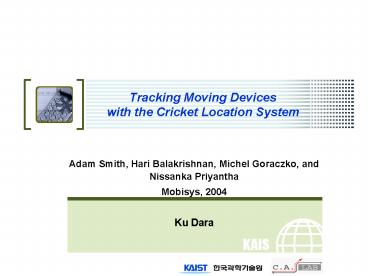Tracking Moving Devices with the Cricket Location System - PowerPoint PPT Presentation
1 / 19
Title:
Tracking Moving Devices with the Cricket Location System
Description:
Direct users to their desired destinations on active map. Players can move in the real world game like Doom or Quake ... Cost high, scalability low, performance high ... – PowerPoint PPT presentation
Number of Views:68
Avg rating:3.0/5.0
Title: Tracking Moving Devices with the Cricket Location System
1
Tracking Moving Devices with the Cricket
Location System
- Adam Smith, Hari Balakrishnan, Michel Goraczko,
and Nissanka Priyantha - Mobisys, 2004
- Ku Dara
2
Contents
- Introduction
- Tracking Algorithm
- Hybrid Architecture
- Evaluation
- Conclusion
3
Introduction(1/4 )
- Location-aware application
Direct users to their desired destinations on
active map
Lacation sensors provide position information to
a moving robot
Players can move in the real world game like Doom
or Quake
4
Introduction(2/4)
- Location-awareness system
Indoor environment
Outdoor environment
Active Badge(infrared)
GPS (Global Positioning System)
Active Bat(ultrasonic)
Hiball tracking system (infrared LED)
Whisper system(audio)
Cricket(RF,ultrasonic)
5
Introduction(3/4)
- Indoor location architecture
Infrastructure receivers
Infrastructure trasmitters
DB
receiver
trasmitter
Cricket system
Active Badge, Active Bat
6
Introduction(4/4)
- Comparison
- Active mobile architecture
- Cost high, scalability low, performance high
- Require a network infrastructure to connect the
deployed receiver to central database - raising privacy concern
- Passive mobile architecture
- Scalability high, cost low, performance low
- Independent privacy concern
7
Tracking algorithm(1/5)
- Three Componets of tracking algorithm
- Lesat-squares minimization(LSQ)
- Use LSQ to reset the bad EKF state
- Extended Kalman filter(EKF)
- Predicte next devices state from samples
- Correct the prediction each time new distance
sample is obtained - Outlier rejection
- Bad distance sample eliminate
t,p,d t current time p known position of the
beacon or receiver d distance btwn mobile device
and known beacon or receiver F a good position
estimate
8
Tracking algorithm(2/5)
- LSQ(Least Squares Minimization)
- If mobile devices were static, a standard way to
solve the problem of estimating is by minimizing
the sum of the squares of the error terms
corresponding to each distance sample - LSQ is complex
- LSQ does not always produce a good estimate
- Use to initializing and reseting the Kalman
filter (bad state)
A
B
9
Tracking algorithm(3/5)
- EKF(Extended Kalman Filter)
- Using a state vector with six components
- Three position components(x,y,z), three velocity
components( ) - Use the most recent distance sample and internal
state to project ahead and produce an estimate of
F of where the device might be in the next
time-step - P model velocity and higher-order derivatives
are zero - PV model acceleration and higher order
derivatives are zero - Multi-modal filter combining the output states
of PV and P models
10
Tracking algorithm(4/5)
- Outlier Rejection
- Wherein egregiously bad distance samples are
eliminated
Outlier Rejection
bad samples
outlier elliminated samples
IF( ?)
True?eliminate False?accept
r residual(guess-actual measurement) ?empirical
ly-selected parameter
11
Tracking algorithm(5/5)
- Tracking algorithm
Measurements
t current time p known position of the beacon
or receiver d distance btwn mobile device
and known beacon or receiver
transmitter
EKF next position extimate
Current estimate distance correct
12
Hybrid Architecture(1/3)
- Problem
- Bad EKFstate
- Extremely different estimate
- Passive mobile system has a higher probability of
reaching a bad state - Rarely happen in active mobile
1
2
3
1
2
3
123
123
123
1
12
123
Recent value
Old value
Passive mobileone sample, inaccurate
active mobilemultiple samples, accurate
13
Hybrid Architecture(2/3)
- Solution
- Normal state passive mode use for Scalability,
user-privacy - Bad Kalman filter state active mode use
14
Hybrid Architecture(3/3)
- Solution
Compute distance samples
RF message
Beacon use a simple CSMA scheme with randomized
back off to avoid RF collisions
ActiveChirp
receiver
Reset EKF
Internal state
15
Evaluation(1/4)
- Experimental setup
- Crickets h/w and s/w
- Computer-controlled Lego train with Cricket
attached to the moving train - Cricket listener to the train, beacons to the
ceiling - Six different speedmodel a range of realistic
pedestrian speeds
16
Evaluation(2/4)
- Error CDF(speed0.78m/s)
- Passive
- Multi-modal(MM)
- 90, error 30cm
- LSQ
- 90,error 50cm (poor)
- Precision MM gt LSQ
- Active
- 90, error 10 cm
- High precision
Occurrence
error(cm)
17
Evaluation(3/4)
- Error CDF(speed1.43m/s)
- Hybrid
- 0.43 m/s 90, 20 cm
- Speed increase, LSQ low precision
High precision
Active-MultiModal
Hybrid-EKF-PV
Passive-MultiModal
Passive-LSQ
Low precision
Act 10cm
P-LSQ 85cm
Hv 45cm
P-MM 65cm
18
Evaluation(4/4)
- Median error
- Hybrid close to active mode
Passive 25cm below
Hybrid 15cm below
Active 5cm below
19
Conclusion(1/1)
- Hybrid architecture
- Preserve the scalability and privacy advantages
of the passive mobile - Improving tracking precision































